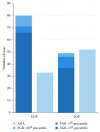Early- and Late-Onset Preeclampsia: A Comprehensive Cohort Study of Laboratory and Clinical Findings according to the New ISHHP Criteria
- PMID: 31637053
- PMCID: PMC6766116
- DOI: 10.1155/2019/4108271
Early- and Late-Onset Preeclampsia: A Comprehensive Cohort Study of Laboratory and Clinical Findings according to the New ISHHP Criteria
Abstract
Recently, the diagnostic criteria of preeclampsia have been changed. No studies are available in the literature that analyzed in detail the differences between early-onset preeclampsia (EOP) and late-onset preeclampsia (LOP), taking into account the International Society for the Study of Hypertension in Pregnancy (ISSHP) criteria. Thus, we sought to retrospectively investigate in detail the differences in clinical and laboratory outcomes between EOP and LOP diagnosed according to the ISSHP criteria. A retrospective cohort study was conducted in 214 women with singleton pregnancies and preeclampsia admitted to the Department of Obstetrics and Perinatology of the University Hospital in Kraków, Poland, from 2013 to 2017 (113 (52.8%) women with EOP and 101 (47.2%) women with LOP). Electronic medical records were reviewed for demographics and medical history, laboratory tests, and delivery and neonatal data. Patients with preeclampsia accounted for 1.7% of the women who delivered during the study period. The EOP and LOP groups did not differ in the distribution of risk factors for preeclampsia. The most common risk factor was primiparity, which was observed in 72.0% of cases. Regarding the ISSHP diagnostic criteria, the two groups differed in the incidence of fetal growth restriction (p=0.0009), hemolysis (p=0.0416), and neurological complications (p=00342), which were found more often in the EOP group. In addition, the EOP group had more frequent occurrence of severe cardiorespiratory (p < 0.0001) and hematological (p=0.0127) complications, adverse fetoplacental conditions (p < 0.0001), and severe fetoplacental complications (p=0.0003). Children born to women with EOP had lower Apgar scores (p < 0.001) and higher rates of intraventricular hemorrhage (p < 0.0001), respiratory disorders requiring mechanical ventilation (p < 0.0001), and early (p=0.0004) and late sepsis (p=0.002). EOP differed from LOP in terms of maternal and perinatal adverse outcomes. The observed higher rates of fetoplacental adverse conditions and severe complications indicate a significant contribution of impaired placentation to the etiopathogenesis of EOP.
Copyright © 2019 Anna Wójtowicz et al.
Conflict of interest statement
The authors declare that there are no conflicts of interest regarding the publication of this paper.
Figures




References
-
- Schutte J. M., Schuitemaker N. W. E., van Roosmalen J., Steegers E. A. P., Dutch Maternal Mortality Committee Substandard care in maternal mortality due to hypertensive disease in pregnancy in the Netherlands. BJOG: An International Journal of Obstetrics and Gynaecology. 2008;115(6):732–736. doi: 10.1111/j.1471-0528.2008.01702.x. - DOI - PubMed
LinkOut - more resources
Full Text Sources

